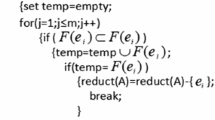Abstract
Notion of soft binary relation is studied here. Some properties of lower and upper approximations with the help of soft equivalence relations are given. Actually, approximations of a subset by a soft binary relation give rise to two soft sets. This new setting is very clear and provides approximations related to every parameter/attribute under consideration. For any subset X, there is an associated fuzzy subset with respect to each parameter. These fuzzy sets are very helpful in decision-making problems. Parametric reduction helps to reduce the size of data. A technique has been presented for this purpose.
Similar content being viewed by others
Explore related subjects
Discover the latest articles, news and stories from top researchers in related subjects.References
Ali MI (2011) A note on soft sets, rough sets and fuzzy soft sets. Appl Soft Comput 11:3329–3332
Ali MI (2012) Another view on reduction of parameters in soft sets. Appl Soft Comput 12:1814–1821
Ali MI, Shabir M (2014) Logic connectives for soft sets and fuzzy soft sets. IEEE Trans Fuzzy Syst 22:1431–1442
Ali MI, Feng F, Liu XY, Min WK, Shabir M (2009) On some new operations in soft set theory. Comput Math Appl 57:1547–1553
Ali MI, Shabir M, Feng F (2017) Representation of graphs based on neighborhoods and soft sets. Int J Mach Learn Cybern 8:1525–1535
Cagman N, Enginoglu S (2010a) Soft matrix theory and its decision-making. Comput Math Appl 59:3308–3314
Cagman N, Enginoglu S (2010b) Soft set theory and uni-int decision-making. Eur J Oper Res 207:848–855
Chen D, Tsang ECC, Yeung DS, Wang X (2005) The parameterization reduction of soft sets and its applications. Comput Math Appl 49:757–763
Davvaz B, Mahdavipour M (2008) Rough approximations in a general approximation space and their fundamental properties. Int J Gen Syst 37:373–386
Fei L, Deng Y (2019) Multi-criteria decision making in Pythagorean fuzzy environment. Intell Appl. https://doi.org/10.1007/s10489-019-01532-2
Fei L, Wang H, Chen L, Deng Y (2019) A new vector valued similarity measure for intuitionistic fuzzy sets based on OWA operators. Iran J Fuzzy Syst 16:113–126
Feng F, Li CX, Davvaz B, Irfan Ali M (2010) Soft sets combined with fuzzy sets and rough sets: a tentative approach. Soft Comput 14:899–911
Feng F, Liu XY, Leoreanu-Fotea V, Jun YB (2011) Soft sets and soft rough sets. Inf Sci 181:1125–1137
Jiang Y, Liu H, Tang Y, Chen Q (2011) Semantic decision making using ontology-based soft sets. Math Comput Modell 53:1140–1149
Kondo M (2006) On the structure of generalized rough sets. Inf Sci 176:589–600
Kong Z, Gao L, Wang L, Li S (2008) The normal parameter reduction of soft sets and its algorithm. Comput Math Appl 56:3029–3037
Ma X, Zhan J, Ali MI, Mehmood N (2018) A survey of decision making methods based on two classes of hybrid soft set models. Artif Intell Rev 49:511–529
Maji PK, Roy AR, Biswas R (2002) An application of soft sets in a decision making problem. Comput Math Appl 44:1077–1083
Maji PK, Biswas R, Roy AR (2003) Soft set theory. Comput Math Appl 45:555–562
Maji PK, Biswas R, Roy AR (2001) Fuzzy soft sets. J Fuzzy Math 9(3):589–602
Molodtsov D (1999) Soft set theory—first results. Comput Math Appl 37:19–31
Molodtsov D (2004) The theory of soft sets. URSS Publishers, Moscow (in Russian)
Pawlak Z (1982) Rough sets. Int J Comput Inf Sci 11:341–356
Pawlak Z (1991) Rough sets: theoretical aspects of reasoning about data. Kluwer Academic Publishers, Dordrecht
Pawlak Z, Skowron A (2007a) Rudiments of rough sets. Inf Sci 177:3–27
Pawlak Z, Skowron A (2007b) Rough sets: some extensions. Inf Sci 177:28–40
Rehman N, Ali A, Ali MI, Park C (2018) SDMGRS soft dominance based multi granulation rough sets and their applications in conflict analysis problems. IEEE Access 31399–31416
Shah N, Rehman N, Shabir M, Ali MI (2018) Another approach to roughness of soft graphs with applications in decision making. Symmetry 10:145. https://doi.org/10.3390/sym10050145
Skowron A, Stepaniuk J (1995) Generalized approximation spaces. In: Lin TY, Wildberger AM (eds) Soft computing. The Society for Computer Simulation, San Diego, pp 18–21
Wu WZ, Zhang WX (2002) Neighborhood operator systems and approximations. Inf Sci 144:201–217
Wybraniec-Skardowska U (1989) On a generalization of approximation space. Bull Pol Acad Sci Math 37:51–65
Zadeh LA (1965) Fuzzy sets. Inf Control 8:338–353
Zhu W (2009) Relationship between generalized rough sets based on binary relation and covering. Inf Sci 179:210–225
Acknowledgements
Authors are thankful to anonymous reviewers and the editors for their very nice suggestions which enhanced the quality of this paper by a great deal.
Author information
Authors and Affiliations
Corresponding author
Ethics declarations
Conflict of interest
All the authors declare that they have no conflict of interest.
Ethical approval
This article does not contain any studies with human participants performed by any of the authors.
Additional information
Communicated by V. Loia.
Publisher's Note
Springer Nature remains neutral with regard to jurisdictional claims in published maps and institutional affiliations.
Rights and permissions
About this article
Cite this article
Shabir, M., Kanwal, R.S. & Ali, M.I. Reduction of an information system. Soft Comput 24, 10801–10813 (2020). https://doi.org/10.1007/s00500-019-04582-3
Published:
Issue Date:
DOI: https://doi.org/10.1007/s00500-019-04582-3




